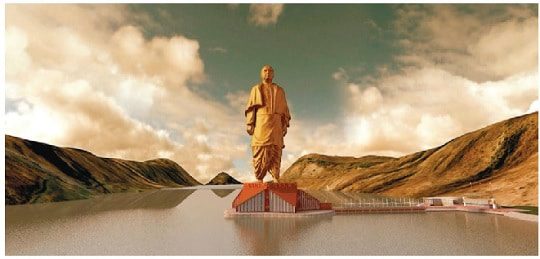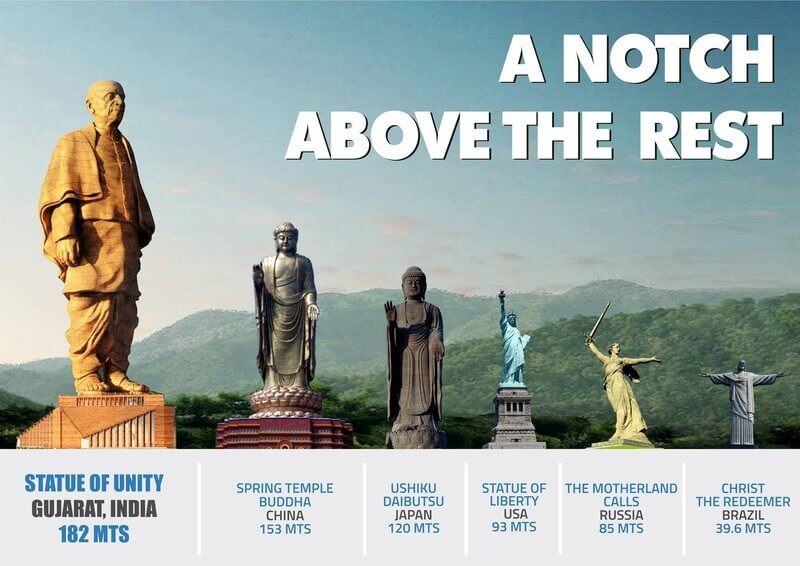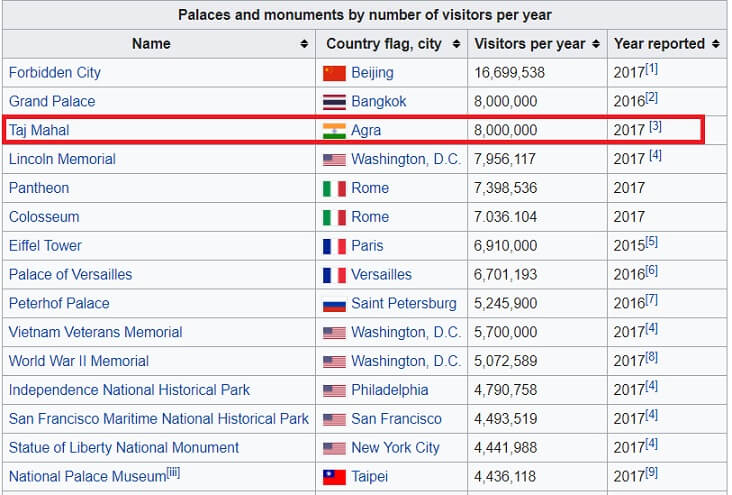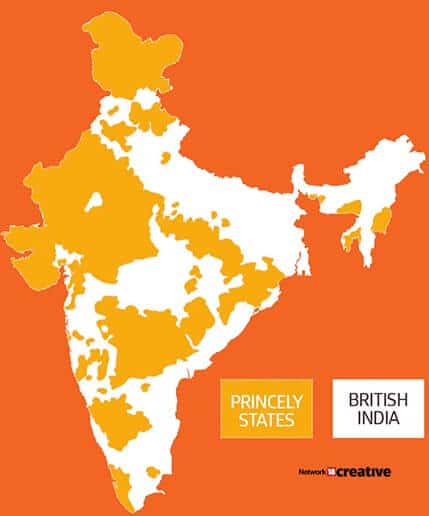Built as a memorial to the ‘Iron Man of India’ Sardar Vallabhbhai Patel, the Statue of Unity built at a cost of over Rs 2,989 crore, will be the largest statue in the world with a height of 182 metres. This article is about the Statue of Unity and man Sardar Vallabhbhai Patel. Why is Vallabhbhai Patel called Sardar?
Table of Contents
About Statue of Unity
“This Sardar Patel statue will be a centre of attraction for tourists from around the world. People who visit should know that India is home to such legendary men. They should see our height. We want that they should measure the height of our nation. And when this statue of unity will be built, for us countrymen, it will be a pilgrimage of inspiration.” PM Narendra Modi
The Statue of Unity is designed as a naturalistic and historically accurate representation of Sardar Vallabhbhai Patel, wearing characteristic garments, in a walking stance. The total height of the statue from its base will be 240-metre consisting base level of 58 metres and statue of 182 metres. The Statue of Unity is almost 29 metres taller than China’s Spring Temple Buddha, the world’s current tallest statue at 153 metres, and almost twice as high as the 93-metre Statue of Liberty in New York. PM Narendra Modi, who was then Chief Minister of Gujrat, had laid the foundation stone for the project on 31 October 2013.
The website www.statueofunity.in has up to date with information about the project.
The Gujarat government expects that an average of over 15,000 tourists will visit the monument daily. The project will generate approximately 15,000 direct jobs for the tribal people every year.
It could have paid for 2 IITs, 5 IIMs & agricultural projects
Located on a river island called ‘Sadhu Bet’, the Statue of Unity is about 3.5 km away from the Narmada dam. A 250-metre long bridge provides connectivity to the island. It is designed to withstand winds, vibrations and earthquake. The monument is designed by Ram V. Sutar, who shot to fame with the 45-feet-high Chambal monument at Gandhi Sagar dam in Madhya Pradesh. Mr Sutar has studied from Sir J.J. School of Art, Mumbai in 1953.
The observation deck, situated at a height of around 500 ft from the river bed, will accommodate up to 200 people at a time. It will provide visitors a panoramic view, enabling them to see the beautiful Satpura and Vindhyachal mountain ranges, the 212 km long Sardar Sarovar Reservoir, and the 12 km long Garudeshwar Reservoir. For the comfort of the visitors against high wind forces, a 400-ton Tuned Mass Damper system has been provided above the observation deck.
It is constructed with steel framing, reinforced cement concrete and bronze cladding. The statue needed 75000 cubic metres of concrete, 5700 metric tonne steel structure, 18500 tonnes reinforced steel rods, 22500-tonne bronze sheets for construction.
- The three-level base of the Statue – exhibit floor, mezzanine and roof – will contain a Memorial Garden and a large continuous museum/exhibition hall, comprising exhibits that focus on the life and contributions of Vallabhbhai Patel.
- Fast elevators to reduce transit time for visitors. There will also be a moving walkway for the disabled and senior citizens.
- A viewing gallery at 153 metres can accommodate up to 200 visitors at a go and will offer an expansive view of the dam, the Satpura and Vindhya mountain ranges and other sites.
- There will also be a museum and a sound and light show depicting the life and times of Sardar Patel.
- A shopping centre.
- A selfie point has been designated a few meters from the statue.
- A 52-room three-star hotel and two tent cities with 250 tents are currently under construction to accommodate the visitors to the site.
Building the Statue of Unity
Built by Larsen & Toubro (L&T), as many as 3,400 workers and 250 engineers worked round the clock for 42 months.
The Statue of Unity is built at a cost of Rs 2,989 crore. The statue was built on a PPP model, with most of the money raised by the Government of Gujarat.
- The Government of Gujarat had allotted ₹100 crore for the project in the budget for 2012-13 and ₹500 crore in 2014-15.
- In the 2014-15 Union Budget, ₹2 billion (US$28 million) were allocated for the construction of the statue.
A consortium of Turner Construction (project manage of Burj Khalifa), Michael Graves and Associates and Meinhardt Group, supervised the project. It took 56 months to complete the project; 15 months for planning, 40 months for construction and two months for handing over by the consortium.
Indian infrastructure company Larsen & Toubro won the contract on 27 October 2014 for its lowest bid of ₹2,989 crore (US$420 million) for the design, construction and maintenance. They commenced the construction on 31 October 2014. In the first phase of ₹2,989 crore (US$420 million) project, ₹1347 crore is for the main statue, ₹235 crore for exhibition hall and convention centre, ₹83 crore for the bridge connecting the memorial to the mainland and ₹657 crore for the maintenance of the structure for 15 years after its completion.
Accenture provides digital media outreach programme.
Comparison of Statue of Unity with Other Statues
Criticism on Construction of the Statue
The construction of the statue faced criticism from several quarters,
The statue is seen as an unsubtle attempt by Mr Modi and his party to undermine the Congress party and appropriate one of its independence-era icons. Sardar Patel was first Prime Minister Jawaharlal Nehru’s deputy, his home minister and a lifelong Congressman.
Local people have opposed land acquisition for tourism infrastructure development around the statue. They also claimed that Sadhu Bet was originally called Varata Bawa Tekri, named after a local deity, and so it was a site of religious importance.
Environmental activists wrote a letter to the central government that this project started implementation without environmental clearance from the ministry.
People of Kevadia, Kothi, Waghodia, Limbdi, Navagam and Gora villages opposed the construction of the statue demanding back land rights of formerly acquired 927 acres of land for the dam and the formation of Garudeshwar taluka. They also opposed the formation of Kevadia Area Development Authority (KADA) and the construction of Garudeshwar weir-cum-causeway project. The government of Gujarat accepted their demands.
When ₹2 billion (US$28 million) was allocated for the statue in the 2014-15 Union budget, several people and the political parties criticised the expenditure for the statue over other priorities like women’s safety, education and agricultural schemes.
Bronze panels were cast at a foundry in China. Hundreds of Chinese workers were also spotted at the construction site. L&T has contracted with TQ Art Foundry; subsidiary of the Jiangxi Toqine Company based in Nanchang, China; for the bronze cladding of the statue. It was criticised by Indian National Congress, the opposition party in Gujarat Legislative Assembly.
Revenue that can be earned through tourism
The entry ticket for the Statue of Unity and viewing gallery is Rs 350 for adults and Rs 200 for children in the 3-15 age group. In 11 Days, Over 1.28 Lakh Tourists Visited the Statue Of Unity.
Assuming 1 million visitors visit the Statue of Unity and buy 350 Rs ticket. Its yearly revenue will be 35 crores. It would take 85 years to break even,(2,989/35).
For Comparison India’s Taj Mahal is the most visited place with 80 lakh visitors per year and earned revenue of 17.88 crores.
As per the Wikipedia article List of most visited palaces and monuments Palaces and monuments by the number of visitors per year is shown in the image below.
As per Factly Entrance Fee at ASI Monuments – Government earned ₹ 284 crores in 3 years Government earns direct revenues through entrance fee at various monuments managed by the Archaeological Survey of India (ASI). Government data indicates that a total revenue of ₹ 284.18 crores was earned in three years between 2013-14 & 2015-16 through entrance fee at 116 different monuments managed by the ASI.
The most visited monument of India, Taj Mahal, generates the maximum revenue. in the year 2015-16, it generated 17.88 crores and Rs 3.66 crores was spent in its conservation.
Sardar Vallbhbhai Patel
“Had Sardar Patel been the first prime minister, the country’s fate and face would have been completely different.”
Vallabhbhai Jhaverbhai Patel (31 October 1875 – 15 December 1950), popularly known as Sardar Patel, was the first Deputy Prime Minister of India. He belonged to the Leuva Patel Patidar community of Central Gujarat. He was an Indian barrister and statesman, a senior leader of the Indian National Congress and a founding father of the Republic of India who played a leading role in the country’s struggle for independence and guided its integration into a united, independent nation. In India and elsewhere, he was often called Sardar, Chief in Hindi, Urdu, and Persian. He acted as de facto Supreme Commander-in-chief of Indian army during the political integration of India and the Indo-Pakistani War of 1947
In 2014, the Government of India introduced a commemoration of Patel, held annually on his birthday, 31 October, and known as Rashtriya Ekta Diwas (National Unity Day). BTW Patel’s date of birth was never officially recorded; Patel entered it as 31 October on his matriculation examination papers.
Vallabhbhai Patel was born and raised in the countryside of Gujarat. He was a successful lawyer. He subsequently organised peasants from Kheda, Borsad, and Bardoli in Gujarat in non-violent civil disobedience against the British Raj, becoming one of the most influential leaders in Gujarat. He rose to the leadership of the Indian National Congress, organising the party for elections in 1934 and 1937 while promoting the Quit India Movement.
As the first Home Minister and Deputy Prime Minister of India, Patel organised relief efforts for refugees fleeing from Punjab and Delhi and worked to restore peace.
He led the task of forging a united India, successfully integrating into the newly independent nation those British colonial provinces that had been “allocated” to India. Besides those provinces that had been under direct British rule, approximately 565 self-governing princely states had been released from British suzerainty by the Indian Independence Act of 1947. Threatening military force, Patel persuaded almost every princely state to accede to India. His commitment to national integration in the newly independent country was total and uncompromising, earning him the sobriquet “Iron Man of India”. He is also remembered as the “patron saint of India’s civil servants” for having established the modern all-India services system. He is also called the “Unifier of India”.
Why is Vallbhbhai Patel called Sardar?
Women of Bardoli bestowed the title Sardar to Vallebhai Patel, which in Gujarati and most Indian languages means Chief or Leader.
The Bardoli Satyagraha of 1928, in the state of Gujarat, India during the period of the British Raj, was a major episode of civil disobedience and revolt in the Indian Independence Movement. The movement was eventually led by Vallabhbhai Patel.
In 1925, the taluka of Bardoli in Gujarat suffered from floods and famine, causing crop production to suffer and leaving farmers facing great financial troubles. However, the government of the Bombay Presidency had raised the tax rate by 30% that year, and despite petitions from civic groups, refused to cancel the rise in the face of the calamities. The situation for the farmers was grave enough that they barely had enough property and crops to pay off the tax, let alone for feeding themselves afterwards.
When a delegation of farmers approached Patel, he told frankly that they should realize fully what a revolt would imply. He would not lead them unless he had the unanimous understanding and agreement of all the villages involved. Refusing payment of taxes could lead to their property being confiscated, including their lands, and many would go to jail. They could face complete decimation. The villagers replied that they were prepared for the worst, but definitely could not accept the government’s injustice.
In 1928, an agreement was finally brokered by a Parsi member of the Bombay government. The Government agreed to restore the confiscated lands and properties, as well as cancel revenue payment not only for the year but cancel the 30% raise until after the succeeding year.
The momentum from the Bardoli victory aided in the resurrection of the freedom struggle nationwide. In 1930, the Congress would declare Indian independence, and the Salt Satyagraha would be launched by Gandhi. It was after Bardoli Satyagraha that Sardar Patel became one of India’s most important leaders.
Video on Sardar Vallabhbhai Patel
This video on Life and Time of Sardar Vallabhbhai Patel
What do you think of the Statue of Unity? Would you like to visit it? Should we spend so much (Rs 2000 crore+) on making the statue? Should our children know about Sardar Patel?









There is poverty, people are homeless and without food, but nothing is done about that. There are crimes, rapes, murders, but nothing is done about that. There is off limit pollution, nothing us done about that. The price of anything and everything is increasing, people are not left with money in their account by the end of the month, but nothing is done about that as well…
True, but it’s world’s largest. And is in India.
How can you support mission to Mars when you have listed this huge list of problems India is facing. Ever heard of “spillover effect”?
In this era will politicians be remembered only by big statues of themselves? What is the job of that statue, that cost so much of money, when people still have to fight for bread for two meals a day?
very Informative and detailed article
You stood tall as Sardar in the historical freedom struggle of India, but you should know that you are also to be the tallest in the world with a height of 182 meters! Can you imagine who built your new avatar and given it strength? The Chinese, and some local adivasi and national labor have worked through nights on the ‘Sadhu Bet’ but you would surely ask, on whose land was this built? Thanks for sharing an informative article.
Absolute waste of money. Should have been spend on creating more schools and colleges.
Bullet train, Statue, Noteban, inhelled stock market, GST all looks
waste of money. Complete wastage